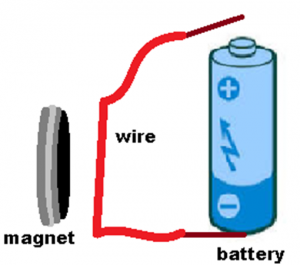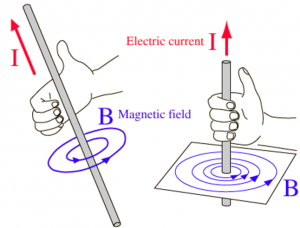A magnet is a device/object that produces an external magnetic field. An invisible field created around the magnet is known as a magnetic field. As we know Electric current is defined as the flow of electrons. In this article, let us discuss the effect of magnet on current carrying wire.
| Table of Contents: |
Experiment To Demonstrate The Effect of Magnet on Current Carrying Wire
Do you know how the magnetic effect works?. To know the effect of magnet on current carrying wire, let’s start with an experiment. You can do this at home with things you can find around you. You will need:
- A battery cell
- 10cm long insulated wire
- Electrical tape
- A strong neodymium magnet
- Pen and paper to record your observation

Step 1: Grab the insulated wire, strip off the insulation around 1 cm on each side.
Step 2: Connect one end of the wire to the positive terminal of the battery, use the electrical tape if necessary.
Step 3: Place a strong neodymium magnet under the wire, do not connect the wire and note down your observations.
Step 4: Now connect the free end of the wire to the negative terminal and see what happens, note down your observations.
Step 5: Now keep the wire as it is and interchange the terminals of the battery, notice what happens. Note down your observations.
Inference: we can see that the wire bends when there is current flowing through it, and when the polarities are inverted the wire bends in the opposite direction.
- A current-carrying wire in a magnetic field experiences a force.
- The magnitude of the force depends on the magnitude of the magnetic field and the current flowing through the conductor.
- The direction of the force also depends on the direction of the current flowing through the conductor.
This is because current flowing through a conductor induces a magnetic field around the conductor, this can be easily understood by the right-hand rule, which states that if you make a thumbs up sign with your right-hand then the thumb pointing in the direction of the current and rest of your fingers indicate the direction of the magnetic field.

When you apply current to the conductor it will produce a magnetic effect or field around it, so basically the wire acts like a magnet, and it will interact with the permanent magnet you have placed next to it, this effect can be reversed by changing the direction of the current, which according to the rule changes the direction of magnetic field produced by it.
We know that in magnets like poles repel and unlike poles attract each other, so depending on the direction of the magnetic field induced, the conductor will either get attracted or get repelled by the permanent magnet.
To learn about the effect of magnet on current carrying wire and Oersted’s Experiment, click on the video below

Frequently Asked Questions – FAQs
What is a magnet?
An object that produces its own magnetic field that interacts with other magnetic fields is known as a magnet.
Define Lorentz force.
Lorentz force is defined as the combination of the magnetic and electric force on a point charge due to electromagnetic fields.
State true or false: A current-carrying wire in a magnetic field experiences a force.
A refrigerator magnet is an example of which type of magnet?
State right-hand rule.
Moving Charges and Magnetism Lecture in Hindi

Hope you have understood the experiment to prove the effect of magnet on current carrying wire. If you have got any doubts regarding this article you can talk to our mentors at BYJU’S.

Comments